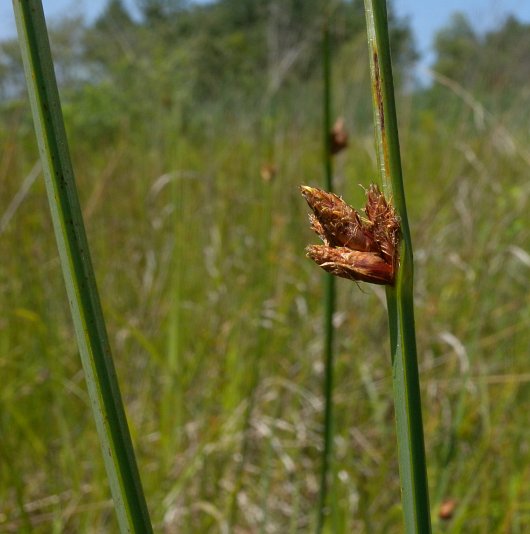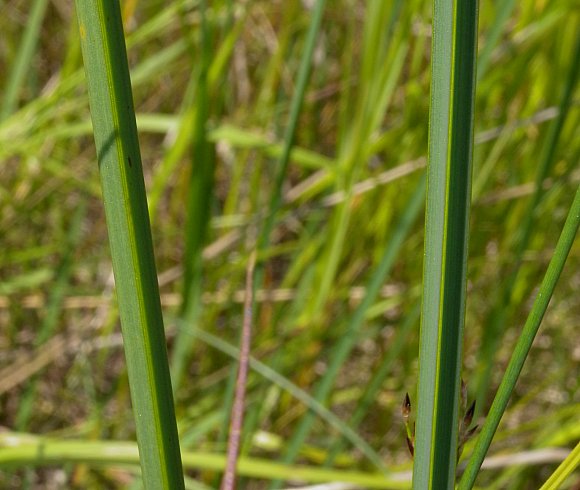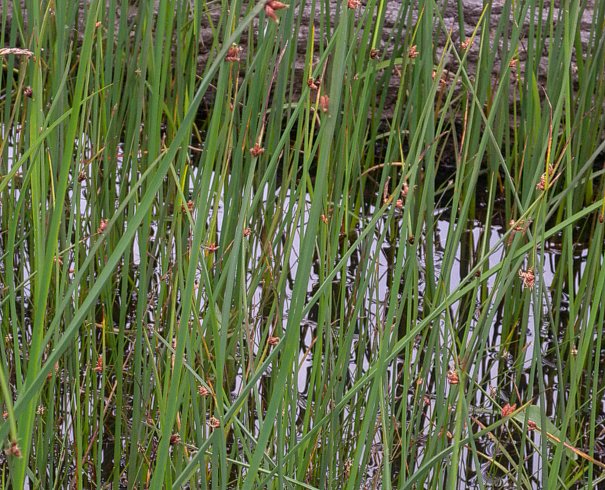
Each spikelet has several perfect florets and their overlapping scales. Each floret has 3 stamens and an ovary with a style that is divided into 2-3 stigmas. The chaffy scales of the florets are 3.5–6 mm. long and 2-4 mm. across; outer scales are larger in size than inner scales. The outer scales are ovate in shape, but they are notched at their tips up to 1 mm. deep. From the midveins of these outer scales, there extends solitary awns up to 2 mm. long. The inner scales are oval or ovate in shape, but they lack significant notches at their tips, and their awns are shorter in length or absent. The blooming period occurs during late spring or summer, lasting about 1-2 weeks for individual plants. The florets are cross-pollinated by the wind. Afterwards, fertile florets are replaced by small achenes about 2.5–3 mm. long and a little less across; they are obovoid-biconvex in shape, brown or olive, and smooth. Each achene tapers abruptly at its apex into a short slender beak. Several fine bristles originate from the base of each achene; they are shorter than the achene or about the same length. The shallow root system is fibrous and rhizomatous. The rhizomes are 1-6 mm. across in diameter, relatively stiff or firm, and reddish brown to reddish white. Colonies of clonal plants are often produced from the rhizomes.
Cultivation: The preference is full or partial sun, wet conditions (including shallow water up to 6" deep), and soil containing sandy loam, silty clay, or gravelly material. This plant can withstand flooded conditions with water up to 2' deep for temporary periods of time, and it can withstand periods of drought when the soil is merely moist, rather than wet. Because of its tough rhizomes and stout stems, a limited amount of wave action and gusts of wind are tolerated. It is easiest to propagate this plant by division of its rhizomes.

Range & Habitat: Common Three-Square is occasional in the northern half of Illinois, while in the southern half of the state it is uncommon or absent (see Distribution Map). However, near Lake Michigan, it can be locally common. This plant is native to Illinois and it is widely distributed in the United States and Canada. Habitats include openings in floodplain woodlands, swamps, wet sandy meadows, sandy and non-sandy marshes, sloughs and swales where temporary water occurs, borders and shallow water of small lakes and ponds, gravel bars and mud bars along rivers, ditches along roadsides and railroads, and powerline clearances in damp sandy areas. Common Three-Square can be found in both high quality and disturbed wetland areas. It is often used in restorations of wetlands.
Faunal Associations: Insects that feed on Common Three-Square (Schoenoplectus pungens) include Plateumaris flavipes (a leaf beetle) and the culm-boring larvae of three Crambid moths: Occidentalia comptulatalis, Schoenobius melinellus dispersellus, and Thopeutis forbesellus (Harms & Grodowitz, 2009). Some bulrushes (Schoenoplectus spp.) are summer hosts of Rhopalosiphum cerasifoliae (Chokecherry Aphid); see Blackman & Eastop (2013). It is possible that many other insects, previously reported to feed on bulrushes generally (Scirpus spp.), also feed on Common Three-Square. The seeds/seedheads of this plant and other bulrushes are an important source of food for many wetland birds, including ducks, geese, rails, and some granivorous songbirds. The Wetland Bird Table has a more complete list of species that feed on these plants. Along with cattails, Common Three-Square and other bulrushes also provide suitable cover, foraging, and nesting habitat for many wetland birds. This includes such species as the Marsh Wren, Yellow-headed Blackbird, Canvasback, Ruddy Duck, American Bittern, Virginia Rail, Sora, Common Moorhen, and Wilson's Snipe (DeVore et al., 2004). Muskrats feed on the rootstocks and aerial stems of these plants.

Photographic Location: A damp sandy area underneath a powerline clearance and sandy border of a small pond in Lake County, Illinois.
Comments: For a long time, Common Three-Square was referred to as Scirpus americanus, but it was later discovered that the original type specimen is actually Scirpus olneyi (Olney's Three-Square), rather than Common Three-Square. Because the three-angled bulrushes have been assigned recently to the Schoenoplectus genus, and Scirpus americanus is an older scientific name than Scirpus olneyi, Olney's Three-Square is now referred to as Schoenoplectus americanus, while Common Three-Square is referred to as Schoenoplectus pungens. As compared to Common Three-Square, Olney's Three-Square can be distinguished by the strongly concave sides of its culms, its shorter floral bract (looking like a continuation of the stem), more slender and flexible rhizomes, and the shorter awns of its outer floral scales. Other similar bulrushes can be distinguished by either their non-sessile spikelets, more numerous sessile spikelets (exceeding 5 spikelets in number), or paler sessile spikelets. Another common name of Schoenoplectus pungens is Chairmaker's Rush because its stems were used in the construction of seats for wooden chairs.